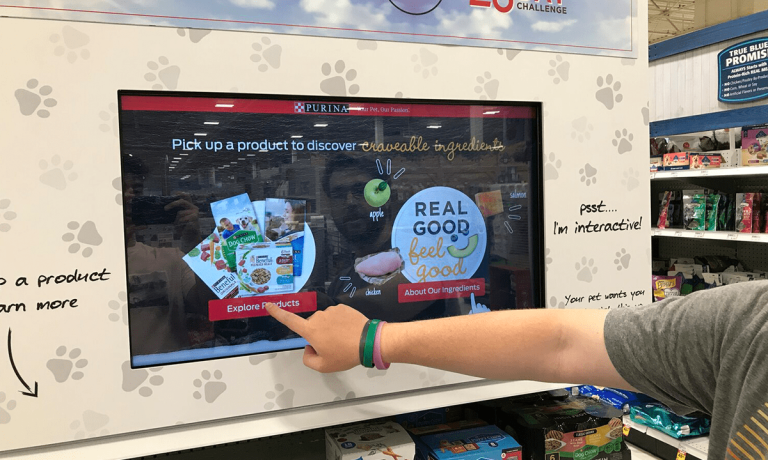Computer vision is transforming the grocery store experience. It is revolutionizing the checkout experience, streamlining the order fulfillment workflow, and now changing the way we purchase products for our pets. Marketing platform Perch, which uses computer vision to create touch-responsive digital media in stores, announced Thursday (June 17) that it has partnered with Nestlé’s Purina pet care brand to create end cap displays that provide shoppers with information about products they touch in real time.
“Eighty-five percent of transactions occur in stores … So we came at it as a fundamental question: why can’t you click on products in store?” Trevor Sumner, CEO of Perch, told Karen Webster an interview. “Brands are forced to try and connect with people before they get to the store, and not when they’re in front of the products, which doesn’t make any sense to us, because when you’re at the store, that’s the point of consideration.”
The “lift-and-learn” partnership features interactive displays at 200 supermarkets in the Midwest. The first displays educate shoppers about the Purina ONE 28-Day Challenge, which encourages customers to try the brand’s products for 28 days to see how it affects their pets.
The launch comes as businesses rethink the physical store in response to the rapid growth of eGrocery, which has been underway for years but was supercharged by the pandemic. Still, even as investors pour billions of dollars into digital grocery delivery companies that claim to have a way to fix the broken economics of the category, the physical store remains essential. Recent research from PYMNTS’ May edition of our Consumers And The New Retail Landscape report finds that more than a third of digital shifters want to shop more in brick-and-mortar grocery stores post-vaccination, and about 3 in 10 digital shifters plan to revert entirely to their pre-pandemic grocery behaviors.
Jumping The Opt-In Hurdle
Perch’s Purina displays do not need to be activated through the press of a button or the scan of a QR code. The information automatically shows up when consumers pick up a product in which they are interested. This, Sumner said, is “the first time you can do product-level marketing in-store in this seamless way.”
Advertisement: Scroll to Continue
He added that most consumers do not want to be looking at their cellphones while they are shopping and physically interacting with products. He joked “imagine the shopping cart accidents that are going to happen.” Perch’s displays, activated by automatic sensors, bypass the need to interrupt shoppers’ in-store experiences.
“You’re not in-store to go hang out on an iPad,” said Sumner, “but if the digital comes to you, you get this 10X effect.”
He noted that, these displays, for which Perch charges $150-$350 per month, lift sales 87 percent on average and that, if one considers someone picking up an object to be analogous to a digital click, the cost-per-click is around half of what Facebook or Instagram charges.
Rethinking The Planogram
According to the company’s data, Sumner explained, much of the conventional wisdom about grocery store layouts is outdated.
“It turns out, most of what we know about [the planogram] is just assumption,” he said. As an example, he cited the widely held belief that the most valuable factor in positioning a product is its level, with eye-level being the best. However, Perch’s data finds that positioning a product at the aisle’s end cap actually drives sales more than positioning it at eye-level, which, he reflected, “challenges decades of planogram design.”
Today’s data collection and analysis capabilities, as Sumner sees it, present an opportunity to call conventional grocery store wisdom into question, replacing what people imagine to be true with what research actually shows. As he put it, “how does your pricing or your messaging or your packaging or your colors change the way people pick up products and convert to sales? We can show you that now.”
He added that stores have the opportunity to “connect brands and shoppers in more meaningful ways,” serving not just as sites of commerce but also as sites of curation, putting care into which products appear on the shelves.
eCommerce, Brick-And-Mortar-ified
From a digital media perspective, Sumner argued, the fact that physical stores retain such a high percentage of customers’ sales marks a huge missed opportunity. As Sumner told PYMNTS of physical stores in a 2018 interview, “your greatest captive audience is right in front of your product and ready to buy right now.”
The lack of digital integrations in most stores can keep brands and retailers from making sales and incentivizing shoppers to adopt novel products. He summarized, “the most barren desert of digital media is where 85 percent of transactions occur,” adding that this digital-free environment significantly limits “the ability of the shopper to make a decision to try something new.”
Sumner believes that, for physical stores to catch up with the digital environment, the physical and digital need to be integrated into one seamless consumer journey.
“I think the next great frontier of digital,” he predicted, “will be how it overlays itself in the physical world, and how we can connect the two concepts together.”




